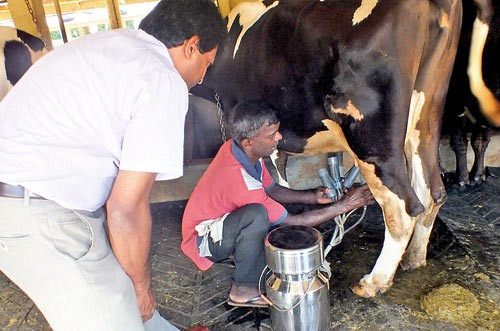Innovative milking machine developed to help small Sri Lankan dairy farmers
Technological applications have revolutionized agriculture and improved food production across the world but in Sri Lanka agriculture has seen very low technological applications.

Dr. K. S.P. Amaratunga watches the milking machine being used.
Most of the farmers in Sri Lanka are poor because they engage in cultivating one crop per season as they do not have an additional income path like animal husbandry- fish, poultry, cattle and dairy farming, in addition to their main crop.
In the case of dairy farming milking cows are reared by non agriculture farmers. For the use of the small scale dairy farmers, two scientists – Dr. K. S. P. Amaratunga and K.F.S.T. Silva, Dept. of Animal Science, Agricultural Engineering Department, (AED), Peradeniya University have invented a milking machine.
In this task the National Science Council (NSF) assisted the project with a financial grant of Rs 1.5 million. Recently, two scientific officers of NSF accompanied the Business Times to the Peradeniya farm where the new machine is being tested.
NSF not only, brings the investors and inventors together but also monitors the progress at all stages once it accepts the proposals of the inventor. Their services are not limited to any category of inventors, whether government or private sector. The NSF works towards ensuring the invention transforms into a marketable product. In Peradeniya, Dr. Amaratunga described how they invented this very useful machine for the SME dairy farmers.
He said that there are a large number of farmers who are rearing a few cows numbering three to four and milking by hand is a tedious job. Further, he said that milking has to be very brisk. Though, machine milking is done in Sri Lanka, it is confined to large scale farms where the cow is brought to the spot where the machine is and the milk is connected to a pipe line to be collected in a central spot.
The machine developed by AED is portable and runs on solar power. Dr. Amaratunga said that he has been handling several projects in collaboration with the NSF since 1997. He said that the machine is tested and now is in the stage of marketing it.
Some 90 per cent of dairy farmers in Sri Lanka are small scale having less than 10 cows and they would not be able to afford the normal milking machine which is costly and not mobile. He said most of these SME dairy farmers do not hsave electricity in their cattle sheds. The research on this novel machine, he said was started in 2000.
The machine operates with rechargeable batteries and power is stored in these batteries with solar power. The batteries could also be recharged with little electricity consumption.
At the cattle shed, Mr. Silva demonstrated how this machine is operated.
Dr. Amaratunga said that under the normal conventional milking machine grid powered electricity is used. The machine needs a large amount of power (over 1000W) to build up the vacuum required for machine milking and this machine is very heavy. Its operational cost is high. The AED developed machine is 10 kg in weight including the 10 litre milk can.
Their specific objectives, he said are evaluation and testing the machine under farm conditions and improving the durability of parts; evaluation of under health status of cows in using the developed milking machine and make necessary changes to the machine to improve the udder health and identifying the difficulties faced by farmers in using the developed milking machine and improving its ergonomics to suit farmers conditions.
Meanwhile the call by the Business Times to reach out to inventors, products and services to profile them and bring to the notice of the authorities the issues these inventors face, resulted in a big response and inquiries are flowing in. In this regard the Inventors Commission has indicated that they could also be helpful to budding inventors.
They could be contacted on 011 2676645-50.


